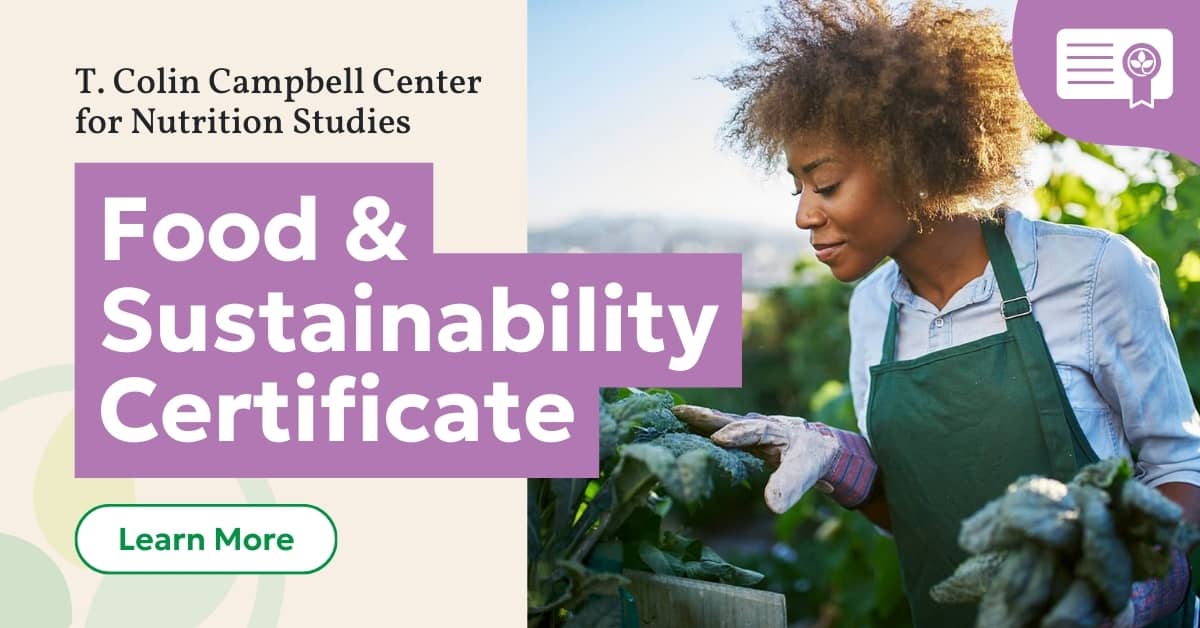

The world’s topsoil is endangered. About a decade ago, a senior UN official made the widely-publicized claim that this most important natural resource, on which our survival depends, will be gone within 60 years if current rates of soil loss continue.[1] “The causes of soil destruction include chemical-heavy farming techniques, deforestation which increases erosion, and global warming”; as the experts warn, “the earth under our feet is too often ignored by policymakers.”
But let’s be honest: It’s not only policymakers ignoring the earth under our feet. It’s nearly all of us. We live in a time when detachment from the natural world and the resources we depend on is the rule, not the exception.
Nothing illustrates this detachment better than our modern food system, a food system of commodities rather than health-promoting foods, of extraction rather than regeneration, and of monocropped fields as far as the eye can see reliant on countless chemical inputs rather than natural processes. In the modern food system, nearly all of us perform the limited role of consumer at the grocery store. We have lost our productive power. Even when we make the healthy choice of bypassing aisles of ultraprocessed foods and heading straight for the produce, do we know where our food comes from or how it was grown or how it arrived at the store or the many repercussions of this supply chain?
This is not any individual consumer’s fault. These patterns are the result of a many-decades-long project euphemistically dubbed the Green Revolution. The more sensible name is the industrial revolution of agriculture, for it has been defined by the increasingly consolidated industry’s almost complete dominance over every facet of the food supply, from seeds to fertilizers, from machinery to pesticides, and everything else in between. If this revolution is green, it is the greenness of money, not life, for modern agriculture is a primary driver of life’s most pressing threats: deforestation, mass extinction, pollution, and dwindling natural resources.
The counterargument is that modern agriculture is also the only way to successfully feed the world’s growing population and that its higher yields are more necessary than ever, but this defense, premised on the idea that a more efficient agriculture is a superior agriculture, too often neglects to account for the blatant inefficiencies within the system.[2] If efficiently feeding a growing population is the most important goal, how do we justify that nearly four-fifths of agricultural land produces just under one-fifth of the global calorie supply?[3]
Transitioning away from diets that require more land opens the door for less intensive practices. This transition requires an increased emphasis on eating more plants, the land use requirements of which compare very favorably to even the least unsustainable meat options.[4]
But what about the natural resource depletion I mentioned earlier? What about soil loss specifically? Some have cast doubt on the claim that we only have 60 years of topsoil remaining.[5] Based on an analysis of soils from around the world published in 2020, some suggest that the crisis is not nearly as catastrophic as it is usually framed.[6] However, even if there is disagreement about the timeline, there is no disputing that diminishing soil quality and quantity are a grave problem. The authors of the paper conclude that 93 percent of conventionally managed soils worldwide are thinning; conversely, “the proportion of thickening soils from the conservation management plots was significantly greater [. . . and] twice as likely to be thickening rather than thinning.”

There were a few limitations in their study. Perhaps most importantly, the researchers only analyzed net erosion. They include the caveat that “there are a range of retrogressive processes that can degrade the soil’s capacity,” and these retrogressive processes—soil compaction, for instance—are not included in their analysis. Also, as they admit, their analysis does not account for fluctuations in the erosion rate, which could increase alongside increased precipitation intensity (which is, in turn, an effect of climate change). With these study limitations in mind, what’s obvious is that we need to collectively shift toward practices that preserve rather than degrade our soil.
They highlight the soil-enhancing potential of several land management strategies, including terracing, cover cropping, conservative tilling, and reforestation. Converting agricultural land to forests or grasslands would, by their estimates, have the greatest net benefit to soil health, but they express concern for what that conversion might mean for total food production, given the growing global population.
You might think this would be the ideal time for them to mention the difference in land requirements between plant- and animal-based agriculture. With less land required to produce the same or more food (to reiterate, almost 80 percent of agricultural land presently produces meat, which provides less than 20 percent of the global calorie supply), widespread rewilding need not be even slightly at odds with meeting the increasing global food demand.[3] What is disappointing, but not unsurprising, is that the authors do not mention shifting diets as a potential solution.
Nearly all the food grown in the world depends on topsoil; unless we can reverse the current trends, there will be widespread famine or a need to shift toward alternative forms of agriculture, such as hydroponic systems. In the meantime, the healthfulness of the food supply is also taking a hit. Numerous studies, including the long-term farm systems trial at the Rodale Institute, have shown that farming methods affect the nutritional quality of produce.[7] In addition to not containing pesticides, organic produce has demonstrably greater concentrations of antioxidants, other phytochemicals, and minerals. The distinction between organic and conventionally grown produce is maybe not as clean-cut as you might think—not all organic-certified farms are necessarily enhancing soil health equally, and it is possible to improve soil health even in conventional systems[8]—but in general, choosing organic is well-founded practice for supporting a more sustainable agricultural system.
For too long, we have cast ourselves adrift from the natural processes on which our survival depends. What’s worse, many of us actively undermine those processes while celebrating the possibilities of technological interventions; this is no substitute for basic behavior change. The diminishing health of soil worldwide is an indication of this systemic rootlessness. But it is never too late to change. Every morning, afternoon, or evening when we sit down for a meal is an opportunity to ground ourselves and support a more sustainable food system.
Learn more about Food and Sustainability.
References
- Arsenault C. Only 60 years of farming left if soil degradation continues. Scientific American. December 5, 2014. https://www.scientificamerican.com/article/only-60-years-of-farming-left-if-soil-degradation-continues/
- Ritchie H. Yields vs. land use: how the Green Revolution enabled us to feed a growing population. OurWorldInData.org. August 22, 2017. https://ourworldindata.org/yields-vs-land-use-how-has-the-world-produced-enough-food-for-a-growing-population
- Ritchie H, Rosado P, Roser M. Environmental impacts of food production. OurWorldInData.org. 2022. https://ourworldindata.org/environmental-impacts-of-food?insight=half-of-habitable-land-is-used-for-agriculture#key-insights-on-the-environmental-impacts-of-food
- Ritchie H. Less meat is nearly always better than sustainable meat, to reduce your carbon footprint. OurWorldInData.org. February 4, 2020. https://ourworldindata.org/less-meat-or-sustainable-meat#article-citation
- Ritchie H. Do we only have 60 harvests left? OurWorldInData.org. January 14, 2021. https://ourworldindata.org/soil-lifespans
- Evans DL et al. Soil lifespans and how they can be extended by land use and management change. Environ. Res. Lett. 2020;15(9). doi:10.1088/1748-9326/aba2fd
- Montgomery DR and Biklé A. Soil health and nutrient density: beyond organic vs. conventional farming. Front. Sustain. Food Syst. 2021;5. doi:10.3389/fsufs.2021.699147
- Montgomery DR, Biklé A, Archuleta R, Brown P, Jordan J. Soil health and nutrient density: preliminary comparison of regenerative and conventional farming. PeerJ. 2022;10:e12848. Published 2022 Jan 27. doi:10.7717/peerj.12848
Copyright 2025 Center for Nutrition Studies. All rights reserved.
Deepen Your Knowledge With Our
Plant-Based Nutrition
Certificate
Plant-Based Nutrition Certificate
- 23,000+ students
- 100% online, learn at your own pace
- No prerequisites
- Continuing education credits











